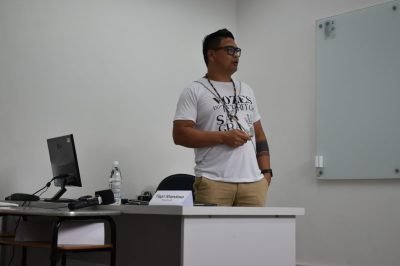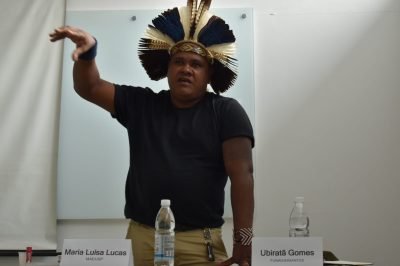Tiago Oliveira (Guarani Nhandewa)
Reclaiming Heritage: The Role of German Ethnologists and Collections for Brazilian Indigenous Memory and Rights
Global Convivial Forum
Roberta Hesse (Mecila / FU Berlin / PPGAS-USP)
The workshop “People, Objects and Ideas Circulation: Transnational Entanglements between Brazil and Germany”, held in the context of the 200th anniversary of German-speaking people’s immigration to Brazil, offered a fresh perspective to reflect upon the relations between Brazil and Germany.
Ubiratã Gomes (Tupi)
In 2024, the Bicentennial of the Immigration of German-speaking people to Brazil is being celebrated. In this context, Mecila, alongside the Museum of Archaeology and Ethnology (MAE/USP) and the Centre for Amerindian Studies from USP (CEstA/USP), organised the workshop “People, Objects and Ideas Circulation: Transnational Entanglements between Brazil and Germany” on March 28th. Hosted by the Museu de Arqueologia e Etnologia (MAE/USP) and coordinated by Dr Barbara Göbel (IAI / Mecila) and myself, the workshop brought together Indigenous leaders and scholars, as well as non-Indigenous scholars, to discuss the role of German ethnologists conducting research in Brazil in the nineteenth and early twentieth centuries and the significance of the collections and knowledge gathered by them for current Brazilian Indigenous groups. A key highlight of the discussion was that despite the importance of these collections for Indigenous groups, they still face significant difficulties in accessing them.
The first panel provided a critical reflection on the contributions of German ethnologists such as Karl von den Steinen, Paul Ehrenreich, Max Schmidt, Theodor Koch-Grünberg, and Curt Unckel Nimuendajú. On the one hand, the discussion highlighted that these ethnologists, motivated by pessimistic romanticism, sought to document the linguistic, material culture, and myths of Indigenous groups they believed were on the brink of extinction or assimilation. On the other hand, Tiago Oliveira (Guarani Nhandewa) (PPGAS-USP), an Indigenous leader and scholar whose ancestors adopted and hosted for many years Curt Unckel Nimuendajú, emphasized how the objects and knowledge gathered by these ethnologists can serve as powerful tools for contemporary Indigenous groups in their efforts to reclaim their memories, languages, myths, and legal rights to territories.
Dr Erik Petschelies (UFRJ) provided an overview of the expeditions conducted by these German ethnologists, discussing their outcomes, and generational differences. He focused on their legacy for Brazilian ethnology and Indigenous policymaking by the state. Karl von den Steinen led the first major expedition to the upper Xingu River region in 1884 and a second in 1887-1888, resulting in an important linguistic classification of the different groups in the area. Paul Ehrenreich conducted an expedition to the Doce River region in 1885 and two others to the Araguaia and Purus rivers in 1888-1889, gathering significant myths from these areas. Theodor Koch-Grünberg undertook two major expeditions, the first to the Negro River region and the second from Roraima to the Orinoco River, compiling a significant collection of myths, that inspired the well-known Macunaíma novel by Brazilian modernist Mário de Andrade. Max Schmidt conducted three main expeditions in Brazil (1900-1901; 1910; 1926-1928) and developed a notable social theory about the Aruak-speaking groups’ relations with other Indigenous-speaking groups, marked by a significant Aruak expansion through economic interdependency, termed “aruakisierung” by the author. It was noted that these ethnographic descriptions and theories suggest a form of emic acculturation practice, not linked to colonialism, wherein different Indigenous groups, with limited contact, had an intensive cultural exchange among themselves. Nevertheless, the impact of these works on German-Brazilian ethnologists such as Herbert Baldus and Egon Schaden, and their influence on Brazilian policy towards Indigenous groups, often had harsh consequences. The romantic legacy played a harmful role, fostering the public perception that in many regions Indigenous groups no longer existed. This perception significantly influenced the policies implemented by the Serviço de Proteção aos Índios (SPI), the Brazilian state agency responsible for Indigenous affairs at the time.

Belonging to a group strongly affected by this perception of assimilation, Tiago Oliveira (Guarani Nhandewa), was raised in an Indigenous community named after the ethnologist Nimuendajú, within the state-recognized Terra Indígena Araribá in western São Paulo state. He explained how the book Die Sagen von der Erschaffung und Vernichtung der Welt als Grundlagen der Religion der Apapocuva-Guarani (1914), by Curt Unckel Nimuendajú, translated into Portuguese in 1987, inspired him to start his career as a researcher. The ethnographic data recorded by Nimuendajú enabled Oliveira, and many other Indigenous school teachers and leaders, to revisit and reconstruct their stories, myths, language, customs, and rituals, which had been suppressed by the state for decades. A strong example he mentioned was how Nimuendajú’s collected kinship data and photographs allowed him to trace his ancestors’ paths, which had been erased or lost from official state documentation. Despite Nimuendajú’s romantic background, Oliveira positively assesses his legacy, as the rich ethnographic data now serves as both inspiration and a source for Indigenous professors reclaiming their stories, myths, and rituals.
The workshop’s second panel delved into the ethnographic collections owned by German institutions and the implications of the circulation of these objects. Dr Maria Luisa Lucas (MAE-USP) presented her research on the collection from Carl Friedrich von Martius and Johann Baptist von Spix, currently owned by the Five Continents Museum in Munich. Through analysing objects and photographs, she encouraged the audience to reflect on how these items produced images of savagery and civilization and suggested that a new perspective on the collections could reveal hidden relationships between different Indigenous groups. While at the collection, she noticed that an object catalogued as belonging to a Witoto-speaking group seemed more characteristic of a Tukano-speaking group, a discrepancy the collection curators acknowledged. The Witoto and Tukano groups lived very far apart, with no known extensive relationship between them. One possible explanation is a simple cataloguing error by von Martius and Spix. However, a more intriguing possibility is that the object’s presence in a Witoto-speaking community indicates a historical exchange and circulation network between these distant groups. This speculative scenario suggests that objects in such collections can serve as historical documents, narrating alternative histories and deepening anthropological and historical understandings.
The panel also addressed the significant challenges Indigenous groups face in accessing these collections and documents. Dr Luisa Valentini (CEstA-USP) conducted an exercise to reflect on what a Kamayurá person might be able to locate from their people’s collections in German institutions. She highlighted numerous barriers, including language obstacles, as most institutional websites are available only in German and English, not Spanish or Portuguese. Additionally, many online catalogues are incomplete, with numerous objects lost during World War II or listed under broad categories like “America.” Furthermore, academic articles and lists about these collections were mostly produced by visiting Brazilian or Latin American scholars, not the institutions themselves. Indigenous partners reported difficulties in getting responses from institutions or even not being properly welcomed to visit the collections. Dr Valentini concluded that, despite current debates about restitution, co-curatorship and participation, Brazilian Indigenous groups remain dependent on well-connected brokers to reach these important collections.

Finally, Ubiratã Gomes (Tupi) (FUNAI / UNISANTOS), an Indigenous leader and an employee at the Brazilian Fundação Nacional do Índio, the current state agency for Indigenous affairs, shared his experiences with documents, reports, objects, and the university. He criticized the severe consequences of misconceptions made by authors like Egon Schaden, who spent less than a week with his group. These misconceptions supported silencing actions by the SPI such as homogenizing various Tupi-Guarani speaking groups into a single category, “Guarani”. Until the 1988 Brazilian Constitution, Gomes’ people were considered Guarani-Nhandewa by the state, and they still struggle for recognition as a distinct Tupi people group. Despite the obstacles he faced in accessing higher education, through his research he managed to reconnect important traces of his people and locate a significant collection about his people abroad. He argued that these collections should not necessarily be repatriated to Brazil, but rather be well-maintained by the institutions, with guaranteed visiting policies for the groups to which they belong.
By bridging past and present, the workshop highlighted how the objects and knowledge collected by German ethnologists can support Indigenous groups in reclaiming their heritage and asserting their rights, if they manage to access them. The insights gathered during the workshop pointed to the essential role of collaboration and accessibility policies for respecting and honouring these very lively groups.
